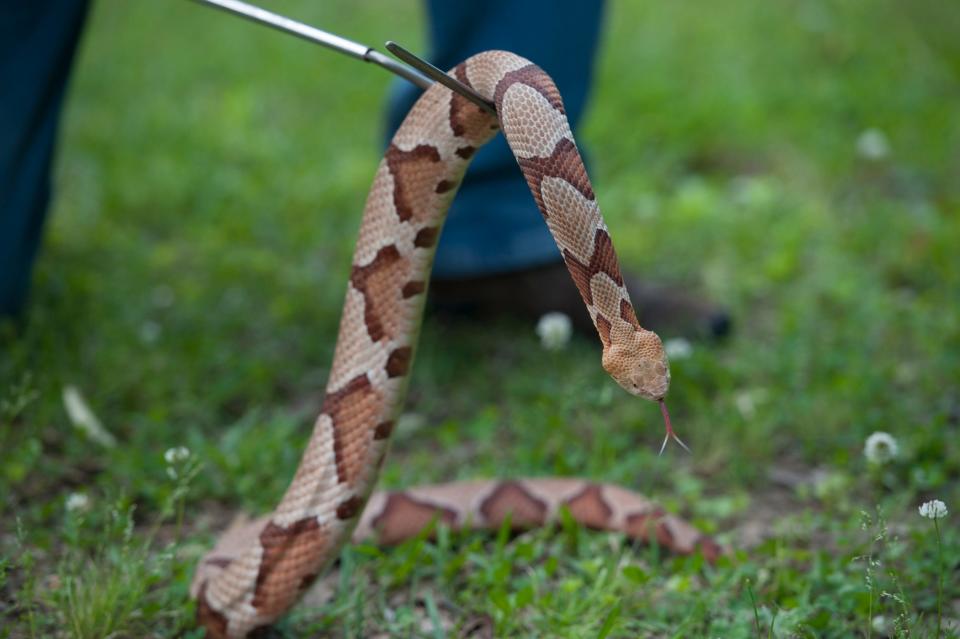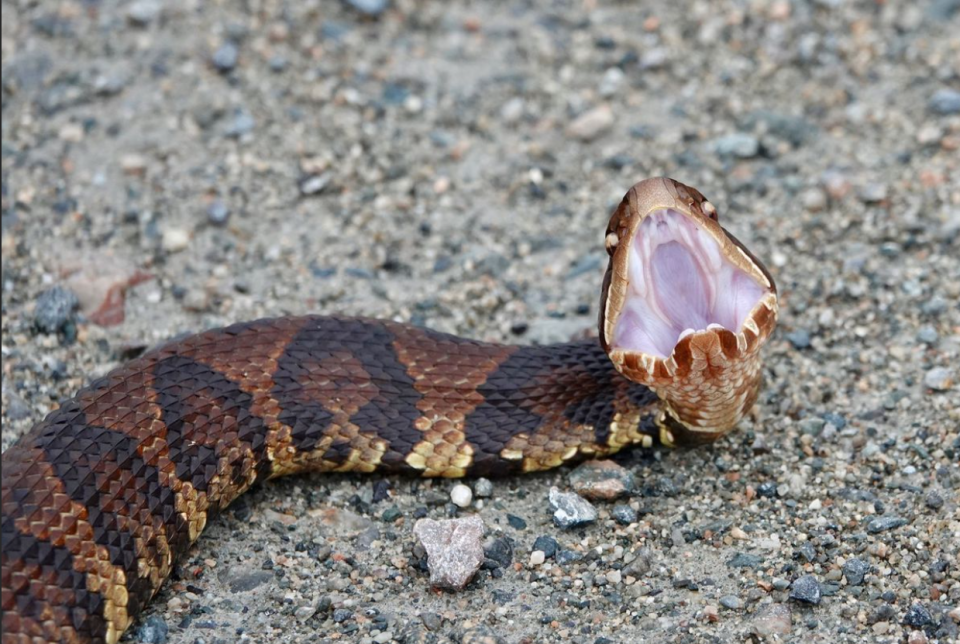How to not get bitten by these three venomous snakes this summer and fall
Snakes get a bad rap.
There are nearly three dozen species of snake in Virginia, and in general snakes are good to have around. They keep the rodent population down, they're basically shy and would rather not encounter humans.
Want more good news? Only three species in Virginia are venomous. While there are many sightings of copperheads, cottonmouths and timber rattlers, many of them are mis-identifications of more common snakes.
The bad news is that between rivers and woodpiles and high grass and rocky slopes, you can probably find a venomous snake within a few miles of where you live.
The good news — so much good news in this story! — is that it's relatively easy to avoid all three of these bad boys if you know what to look for.
Whether you're high in the hills or at the edge of a body of water surrounded by woods, or in your own backyard about to grab some wood from the woodpile, you may encounter snakes. And those encounters can happen beyond the summer months and into the fall, according to Matthew Painter, a Nurse Practitioner at Augusta Health.
"Yes, we have had snake bites into October," Painter wrote in response to questions from The News Leader. "Particularly in the warmer fall seasons we have experienced over the last years. It is more about the snake hibernation cycle" than anything else, like the hatching season, Painter wrote.
So with the warmer spring have there been more snake bites in the area? "To my knowledge we have not seen any more cases than in prior years/seasons," Painter wrote. Statewide there have been more calls to the poison center than in the previous year.
What to look for, and what to look out for
According to The Cleopatra Project: Poisonous and Venomous Animals in Virginia, snakes generally look for sunny rocks to heat themselves up on cool days, and shady places to stay cool on hot days. In downtown Staunton, large rat snakes and smaller garters — both non-venomous — have been found in backyards, sunning themselves on a sidewalk or concrete wall, or coiled in the branches of evergreen shrubs.
The venomous snakes have certain physical characteristics in common:
Their heads are more diamond-shaped than other area snakes,
their pupils are vertical like a cat's, and
they have both nostrils and heat-sensing holes on either side of their heads.
So which snakes pack poison, and how do you identify them?
Eastern copperhead

If you are unlucky enough to be bitten by a venomous snake in Virginia, the chances are it's going to be by the Eastern copperhead.
That's not because they are more aggressive; they're just more prevalent in fields, forests, as well as suburban and even urban surroundings.
Copperheads are recognizable by their hourglass rings, but there are non-venomous snakes whom evolution has favored with patterns that look similar.
"The most common venomous snake bite we see in our area is from copperhead snakes," wrote Painter. "Thankfully, copperhead bites are rarely life threatening as they deliver a low dose bite for humans.
"They can be quite painful and will cause tissue damage and swelling. In our area copperhead bites typical occur from May to July with the peak in July."
Timber rattlesnake
Rocky hill country means rattlers.
But you may also encounter a Timber rattler in more mountainous terrain, and in forests in the Shenandoah Valley.
It's not exactly true that a rattlesnake will always rattle before it bites, Painter said. If it's surprised it will bite first and rattle later, or not at all. "Often the victim never sees the snake after the bite, if in dense brush," he said. It's also not exactly true that a rattle tells you how many years old a Timber rattler is (they add to their rattles each time they shed their skin, which does not occur like clockwork). The best thing to know about a rattlesnake's rattle is that you will be safer to move away from it rather than stick around and try and count the rings.
Rattlesnake bites happen around the same time of year as copperhead bites, Painter said, "and are definitely more dangerous, as the venom is more concentrated."
Northern cottonmouth (water moccasin)

The cottonmouth is semi-aquatic. It can swim both on the surface of rivers and ponds and also underneath the surface. The cottonmouth displays the distinctive pillowy white mouth when it opens its jaws. Just because you see a snake in the water does not mean it's a cottonmouth.
But if you are along the edge of a body of water and smell a distinctly out of place melon-like scent, that could be the cottonmouth's musk. Walk away!
When pit vipers attack! (Or, they really don't want to attack you.)
All 3 of these are known as pit viper snakes, according to Painter. "The venom is tissue-destructive as a predigestive enzyme causing changes to the blood cells and clotting cascade. This usually results in a slow progression of symptoms for the bite victim.
Just because a snake is non-venomous does not mean it won't bite. The best thing to do is not get close enough to find out.
"Non-poisonous snakes can bite as well and may cause skin infections. Often people will think they were bitten by a poisonous variety when it was not, as they may look similar," Painter told The News Leader.
Don't panic!
"People still assume a snake bite is going to ultimately kill them. This is rarely the case," Painter said. He says that misapprehension leads to "undue panic and unsafe actions, such as driving too fast to get to the Emergency Department. Try to stay as calm and seek medical attention."
Once you're bitten, you do NOT have to try to catch the snake, cut its head off, make a tourniquet, or suck the venom out of the wound.
"It is not necessary to catch the snake or cut off its head and bring it to us for identification. We have had people bitten again trying to do this. If you can describe what it looked like that will be helpful, but the medications we use are universal to all the snakes endogenous to our area."
What you should do, Painter says, is get yourself calmly to medical help.
"Do not mess with a snake — many of the bites I have cared for in my career involved people trying to catch a snake. A provoked attack bite versus a warning 'get away' bite is much worse."
Other snake facts from Matthew Painter:
Bees v. snakes. Virginia ranks 5th (the highest in North Carolina) in the nation for snake bites with a ratio of 49 bites per one million people per year or about 400-425 bites per year. Of these bites the death rate is extremely low with only 15 deaths in 30 years of data in Virginia. Bee stings are much more common, but have about the same death rate as snake bites.
Painter recommends medical evaluation for all snake bites, even if you think it was a non-poisonous species.
Most snake/human problem encounters occur when the snake is threatened such as stepping on or near it. Be alert if you are where snakes may be — brush, logs, rocks, trails etc. Look before stepping, sitting or grabbing. Snakes are not naturally aggressive; they will avoid you if possible. A walking stick may be helpful to plant in front of your steps and make noise in advance of you entering their space. High boots and socks may offer protection from a bite.
If bitten move to safety and simply cover the area and get medical help by calling 911 or going to the Emergency Department. Painter does not recommend driving yourself — if the snake was venomous then as the venom progresses your blood pressure may drop and you can become dizzy.
This article originally appeared on Staunton News Leader: It's still snake season. Here's what to know about the venomous snakes here.

